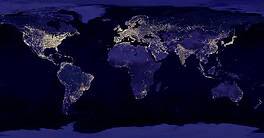BANKERS GET READY FOR REBOUND IN WORLD TRADE
Trade finance and risk management services are in growing demand as world trade recovers and credit issues remain a concern.
By Gordon Platt
The outlook for global trade is improving as the world economy recovers, and trade bankers are gearing up to handle the growing volumes while helping their customers introduce new efficiencies in their global supply chains. Some 90% of world trade involves some type of credit, insurance or guarantee, according to the World Trade Organization.
Lack of financing was part of the reason for a decline in world trade last year, the first time global trade shrank since 1982. Normally, structured trade finance is countercyclical. When the economy slows and liquidity dries up, traders demand letters of credit to lower the risk of doing business. This time around was different in some important ways, however, due to the scope and severity of the financial crisis.
Before the crisis hit, it was normal to treat credit as a commodity that was available when needed at an affordable price. With the popping of the credit bubble following the bankruptcy of Lehman Brothers, liquidity became scarce, and financial institutions became fearful to lend. Banks and corporations became extremely cautious about whom they chose to do business with.
Emerging markets were especially threatened when the withdrawal of trade credits in late 2008 severed their lifeline to the global markets. Trade finance pricing went through the roof, and a lot of transactions did not get done because credit was simply not available.
Major trade banks, working with export credit agencies (ECAs) and multilateral institutions, such as the International Finance Corporation (IFC), developed innovative financial products and stood behind their customers during the credit crunch. They found new ways to lower risks, restore trust and accelerate trade cash flows for their customers.
Global Finance editors, with input from industry analysts, corporate executives and technology experts, selected the best trade finance providers in 71 countries or regions. Criteria for choosing the winners included transaction volume, scope of global coverage, customer service, competitive pricing and innovative technology.
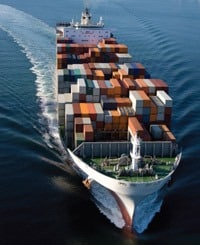 Most banks integrate trade finance services with cash management and foreign exchange advisory services. Besides issuing documentary credits and guarantees, banks lend against invoices, issue packing credits, handle credit inquiries from overseas counterparties and offer many other trade-related services.
Most banks integrate trade finance services with cash management and foreign exchange advisory services. Besides issuing documentary credits and guarantees, banks lend against invoices, issue packing credits, handle credit inquiries from overseas counterparties and offer many other trade-related services.
Bankers say there is enough trade finance capability in the market to handle current needs, but they are working to ensure that they are in a position to support their customers when demand grows. During the next 18 months there will be a lot of government involvement in economies around the world, as large infrastructure and power plant projects are started, bankers say. The weak dollar puts the United States in a very price-competitive position. US-based companies will be able to bid aggressively to build power plants in India, for example. The need for alternative energy sources is growing to forestall climate change, and the US is the leading center of green technology, creating opportunities for export gains. Trade bankers are optimistic about their prospects in the year ahead, not only in the US but all around the world.
REGIONAL WINNERS
Americas
Citi
Citi provides trade finance services to more clients in more countries than any other bank. It has a local presence in trade services in 80 countries as well as an integrated platform that enables it to support cross-border flows. Trade finance can be a countercyclical business, and Citi has seen a steady resurgence in demand for these services as the global economy has faltered in the past 12 to 18 months. “Trade has become a hot talking point as a result of what is going on in the world economy, and this highlights our strength in providing a world view and innovative financing structures with the help of ECAs [export credit agencies] to provide global liquidity,” says John Ahearn, managing director and global head of trade, who is based in New York.
Citi created a $1.25 billion trade finance facility last June in partnership with the International Finance Corporation (IFC) for lending to exporters. Some 85% to 90% of the facility has been drawn down, Ahearn says. “We wanted to know if the shortage of credit for trade finance was depressing world trade, or whether there was a lack of demand,” he says. “We were able to take the first of those questions off the table.”
In Latin America Citi provides trade services from offices in 22 countries. “Historically, the region has had strong trade ties with the US, and this is still the case in many of the countries,” Ahearn says. “But China and other Asian countries are aggressively expanding their trade with Brazil and other Latin American nations, particularly in commodities.” Citi identified this trend four years ago and put together a team to leverage these flows, Ahearn says. “We originate transactions in China, and our team in Latin America facilitates those trades and mitigates risks,” he says.
Europe
BNP Paribas
BNP Paribas is one of the top three trade finance banks globally in terms of volume. The Paris-based bank has a pan-European presence and a global network of 100 trade centers with teams of advisers who specialize in all aspects of international commerce. Its deep knowledge of the European market, combined with its conventional trade products and tailored solutions to meet the financing needs of its clients, are some of the reasons for BNP Paribas’ success, says Pierre Veyres, global head of Global Transaction Banking (GTB), a new unit that combines all flow-banking activities into one unit. GTB includes global trade solutions, international cash management and correspondent banking.
The robust profit generation of BNP Paribas Group in all regions of the world enabled it to benefit from the flight to strength and safety during the global financial turmoil of the past two years. “We were even more supportive of our customers than usual during this period and used our creativity to meet their needs,” Veyres says.
BNP Paribas serves importers and exporters in emerging markets in addition to large and mid-size corporations in the developed countries. Globalization has made it a challenge to manage the intricate supply chains of multinationals. “A successful trade bank cannot be in just one region,” Veyres says. “It must be in all geographies, so that it can be on both sides of transactions, and it must offer strong products through an efficient delivery system.”
BNP Paribas processes more letters of credit in France than any other bank. It helps companies manage their payables and receivables, with teams working together across the organization.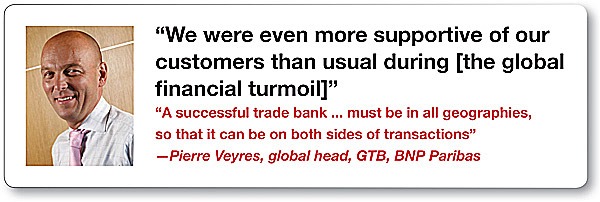
Asia
Standard Chartered
Standard Chartered is one of the top three trade banks in the world, with a specialty in emerging markets. It is the first bank to offer buyer and supplier finance on a cross-border basis in Asia and the Middle East. “Trade is in our DNA,” says Tan Kah Chye, global head of trade finance. Even though international trade declined by 15% to 20% in most regions of the world in 2009, Standard Chartered supported trade flows that were just as high as a year earlier, as it gained market share, he says. The comparison is all the more striking in that 2008 was the strongest year ever for trade.
Asian economies were able to recover from the global financial crisis a lot faster than those in other regions, says Tan, who is based in Singapore. “Trade finance was available at a much lower price in Asia, so many banks booked their financing in this part of the world,” he says.
Global trade hit bottom in June or July 2009 and has been recovering at a very slow pace since then, Tan says. “This extremely slow recovery will probably continue until the fourth quarter of 2010 before there is much change,” he says. Intra-Asia trade is growing much faster than world trade as a whole, he adds. “India, which was a closed, domestic economy, has been increasing its imports dramatically in the last five years, and China today is a big consumer-driven economy,” he says.
Companies are moving away from letters of credit and doing more business on open account using wire transfers, according to Tan. This is especially the case with domestic and regional trade in Asia, he says. “A lot of banks have taken their eye off domestic trade, and they are leaving a lot of money on the table,” he says.
Nordic Region
SEB
SEB is one of the largest trade finance banks in the Nordic region, a highly export-oriented area, where exports average about 60% of gross domestic product. SEB serves the vast majority of the largest corporations and the major global trading companies based in the region as they continue to expand globally. The bank’s success in the trade area is due in part to its methodology, or the way it does business, says Patrik Zekkar, SEB’s acting global head of trade finance. “Our Trade Finance Value Chain, introduced two years ago, has changed the whole concept of how trade finance is handled,” he says.
By outsourcing a large part of its back-office services, taking advantage of the latest technology and economies of scale, SEB is able to concentrate on advisory, service and innovation. “We focus on the whole value and supply chain and the working-capital aspects of trade finance, helping our clients to cut costs and reduce the trade cycle by days or even weeks,” Zekkar says. “Our products and services include much more than just risk reduction. We optimize trade processes and cash flow,” he says.
SEB was the first bank to create an online trade finance community, the Benche, where users can share their specialized knowledge and provide answers to questions about doing business in tough markets, regulatory changes and other developments.
The bank’s trade finance volume increased dramatically in 2009, showing a 70% increase from a year earlier. The biggest growth areas for trade were quite evenly distributed between Asia, South America and Africa, Zekkar says. SEB operates 17 trade offices around the world and partners with thousands of correspondent banks. Speed, accuracy and flexibility are accomplished by integrating trade finance with the overall financial system of a company, he adds.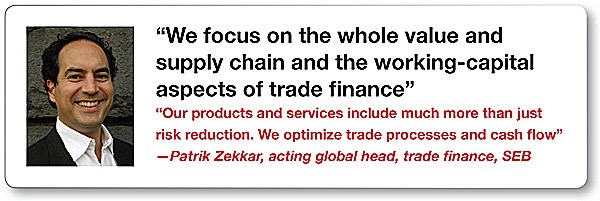
Central & Eastern Europe
UniCredit Group
UniCredit Group has an in-depth presence in Central and Eastern Europe, where it operates indigenous banks with large market shares in 19 countries. It is the CEE banking leader, with significantly more assets than its nearest competitor and more branches. “UniCredit’s product line, Global Transaction Banking, has more than 2,000 specialists across different regions with longstanding technical experience,” says Markus Wohlgeschaffen, head of global trade finance and services. “We combine local expertise with the competency of a global transaction bank,” he says.
As the leading trade finance bank in the CEE, UniCredit offers the full range of traditional trade products as well as complex cross-border supply-chain finance solutions. “We offer risk mitigation and cost saving along the entire supply chains of our customers,” Wohlgeschaffen says. “UniCredit’s banking network provides, if needed, technologically advanced, most complex cross-country solutions to enable financially demanding transactions.”
Andrew England, head of global transaction banking, CEE, at UniCredit, says the bank takes a long-term view of the market and is adding trade finance professionals across the region. “We are committing people to develop what is a strategic business for us,” he says. In the past year UniCredit has added more trade bankers in Russia, Croatia, Hungary and the Baltic states, he points out.
“The big emerging markets of Russia, Poland and Turkey are becoming more confident and will have the fastest economic growth in the future, while trade flows will grow even faster than gross domestic product,” England says. Russia drives a lot of trade in the region, particularly in commodities, including oil, he says. “Turkey is becoming an economy of choice and is developing its global business relationships, while Poland is in the best health of all CEE economies.”
Some CEE countries are closely linked to Western Europe for trade and infrastructure investment, England says. “With its base in Italy and strong presence in Germany and Austria, UniCredit has traction in these developed countries that have strong connections with the CEE,” he says. “We can route the trade business and get on both sides of transactions.”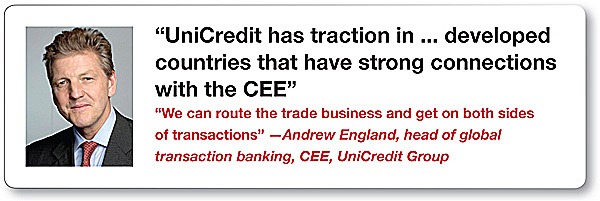
Middle East
Arab Bank
Arab Bank’s financial strength is key to maintaining its support of its customers through any economic climate, says Abdel Hamid Shoman, chairman and CEO. “Arab Bank follows a conservative and disciplined policy, allowing credit lines to remain open to key and creditworthy customers,” he says. “This has been the culture cultivated since the bank’s inception, and it has served the bank well, ensuring that it continues to be a leading provider of banking facilities in its niche markets,” Shoman adds. This is especially important in international trade, allowing customers to have minimal interruption of their business, he says.
Arab Bank has created a Cash Management and Trade (CMT) business line, with services that enable customers to free up needed resources and focus on their core business. “Arab Bank supports their transactional efficiency through its global network of more than 500 branches in 30 countries,” Shoman says. “Our expertise and physical presence extends to Asia, allowing our local teams in China, South Korea and Singapore to work closely with our institutional and corporate customers in the region to ensure seamless delivery of products and services.” Some of the bank’s customers are tapping into capital flows that are still available in Asia compared to other regions.
In today’s global market, international trade is complex and inherently subject to a variety of risks, Shoman says. “Our approach is to work with our customers to increase their awareness of potential risks and to manage these risks in the best possible manner,” he says. “We are product experts and also well versed in the local environment, which ensures that customers benefit from a well-rounded approach.”
While trade between the Middle East and Asia is booming, intra-regional trade is also growing, and there is room for further expansion, according to Shoman. Local manufacturing should benefit from increased domestic investment, he says. Improved port facilities and a simplified administrative process would help from a structural perspective, he adds.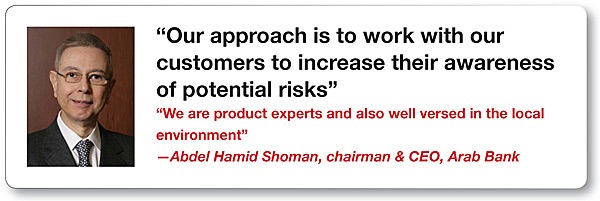
Africa
Standard Chartered
Standard Chartered is a strong commercial bank with deep relations with its customers. “We are able to penetrate right down to the SME [small and mid-size enterprise] level,” says Tan Kah Chye, global head of trade finance. Trade is not a stand-alone business, he says. A whole series of transactions can be triggered by a trade deal. “We become involved very early in the process,” he says. “Take the case of a farmer in Africa. The financing has to happen well before the seeds get into the ground.” The farmer has to buy the seeds. Then he has to buy diesel fuel to plow his fields. He also has to buy fertilizer, and so on. “Standard Chartered follows agricultural financing all the way through to the supermarket,” Tan says.
When trade financing froze up following the bankruptcy of Lehman Brothers in the fall of 2008, there was a significant slowdown in world trade. “Standard Chartered recognized early on that the crisis would be deep and bite our customers quite hard,” Tan says. The bank was instrumental in working with the IFC, a member of the World Bank Group, to implement an innovative program to pump liquidity into the trade finance market to jump start world trade and provide working capital.
The Global Trade Liquidity Program is projected to support incremental trade flows of about $50 billion in more than 90 countries. Standard Chartered’s share is more than $15 billion in 35 developing countries and will benefit more than 30,000 importers and exporters.
Standard Chartered has 155 branches in 13 African countries. It is the leading trade finance bank on the continent and number one in Swift trade-message volume. With its extensive presence in Asia, the bank is ideally positioned to handle growing trade flows between the two regions. “It is not only China that has an interest in Africa,” Tan says. “A lot of other countries are getting involved. Trade used to be centered in energy and commodities, but now it is broadening out,” he notes. Standard Chartered has long been active in warehouse financing for soft commodities, such as wheat, rice and soybeans. “In the last few years, we have been moving up the value chain,” Tan says.
|
Angola : BES Angola |
Malaysia : HSBC Bank Maybank |
|
Argentina : Banco Santander Río |
Malta : HSBC Bank Malta |
|
Australia : ANZ |
Mexico : Banamex |
|
Austria : Bank Austria |
Netherlands : Royal Bank of Scotland |
|
Bahrain : Arab Banking Corporation |
Nigeria : First Bank of Nigeria |
|
Belgium : KBC |
Norway : DnB NOR |
|
Brazil : Itaú Unibanco |
Oman : BankMuscat |
|
Canada : Scotiabank |
Pakistan : Habib Bank |
|
Chile : Banco Santander Chile |
Philippines : Bank of the Philippine Islands |
|
China: China Construction Bank |
Poland: Bank Pekao |
|
Colombia: Bancolombia |
Portugal: Banco Espírito Santo |
|
Czech Republic : CSOB |
Qatar: Doha Bank |
|
Denmark : Nordea |
Russia: VTB Bank |
|
Egypt : Commercial International Bank (CIB) |
Saudi Arabia: SABB |
|
Estonia : Swedbank |
Singapore: DBS |
|
Finland : Nordea |
Slovakia : Tatra Banka |
|
France : BNP Paribas |
South Africa : Standard Bank |
|
Georgia : Bank of Georgia |
South Korea : Korea Exchange Bank (KEB) |
|
Germany : Deutsche Bank |
Spain : Banco Santander |
| Greece : Eurobank EFG | Sweden : SEB |
|
Hong Kong : HSBC |
Switzerland : Credit Suisse |
|
Hungary : K&H; Bank |
Taiwan : Taipei Fubon Commercial Bank |
|
India : HDFC Bank |
Thailand : Kasikornbank |
| Indonesia : Bank Danamon | Turkey : Akbank |
|
Israel: Bank Hapoalim |
Ukraine : UniCredit Bank Ukraine |
|
Italy: Intesa Sanpaolo |
UAE: Mashreq |
|
Japan: Mizuho Financial |
UK : HSBC |
|
Jordan: Arab Bank |
US: Citi |
|
Kazakhstan: ATFBank |
( Honorable Mention: JPMorgan Chase) |
|
Kuwait: National Bank of Kuwait |
Venezuela: Banco Mercantil |
|
Latvia: Swedbank |
Vietnam : Saigon Hanoi Commercial |
|
Lebanon: BLOM Bank |
|
|
Lithuania: Swedbank |
Yemen : Arab Bank |



